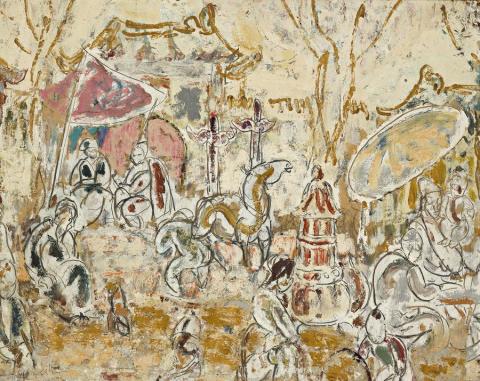TEMPLE YARD, PEKING, 1936
IAN FAIRWEATHER
oil and pencil on paper on board
50.0 x 62.0 cm
signed lower left: I Fairweather
Collection of Lina Bryans, Melbourne
Thence by descent
Private collection, Melbourne
Recent Paintings by Ian Fairweather, RedfernGallery, London, 7–30 January 1937, cat. 14 (label attached verso)
Continental and English Paintings, Redfern Gallery, London, 1937, cat. 34 An Exhibition of Art for Theatre and Ballet, Myer Art Gallery, Melbourne (arranged by the British Council and Redfern Gallery),1940, cat. 91 (as 'Oriental Decor')
Fairweather: a Retrospective Exhibition, Queensland Art Gallery, Brisbane,3 June – 4 July 1965; Art Gallery of New South Wales, Sydney, 21 July – 22 August 1965; National Gallery of Victoria, Melbourne,9 September – 10 October 1965; National Gallery of South Australia, Adelaide, 26 October – 21 November 1965; Western Australian Art Gallery, Perth, 9 December 1965 – 16 January 1966; Tasmanian Museum and Art Gallery, Hobart,10 February – 13 March 1966, cat. 71(label attached verso)
Landfall: The Captain James Cook Bi-Centenary Exhibition of Australian Art, National Gallery of Victoria, Melbourne, 1970 Ian Fairweather 1891-1974, National Gallery of Victoria, Melbourne,1991, cat. 3 (label attached verso)
Thomas, L., 'The Hand of the Master: From Complexity to Seeming Simplicity', Bulletin, Sydney, 4 December 1965, p. 38
Bail, M., Fairweather, Murdoch Books,Sydney, revised edition 2009, pp.15, 51, 247, cat. 37, pl. 30 (illus.)
In 1965, when the Ian Fairweather retrospective exhibition organized by the Queensland Art Gallery began its 'triumphal tour',1 Fairweather was hailed as 'a truly great painter - an artist of impressive world standing'.2 This 'magnificent exhibition' ranged from the masterly, meditative paintings of the stature of Epiphany, 1962 (Queensland Art Gallery, Brisbane) to the vibrant Temple Yard, Peking, 1936 lent by Lina Bryans.3 It was one of a number of treasured works from her collection of Fairweather's works, including Boats at Soochow Creek, 1938, AlligatorCreek, Cairns, 1939, and Landlady and Daughter, Cairns, 1941 (lots 12 and 13). Writing in the introduction to the exhibition, its curator Robert Smith, referred to Fairweather's arrival in Melbourne in the early thirties and his impact on 'a small band of artists and collectors'.4 He continued, 'Fairweather's paintings still showed signs of his Slade School training and the influence of the New English Art Club, but he was already beginning to merge the modern art of Europe with the ancient art of Asia. To members of the recently formed Melbourne Contemporary Group his emphasis on formal values was a vindication of their own position.'5
Fairweather spent two periods in China, from 1929 to 1933, and again in 1935-36. His time in Peking in 1936 and later recollections inspired the creation of a number of brilliant paintings- especially Tombs in Peking, 1936 (sold Deutscher and Hackett, Sydney, 17 November 2010) and Tethered Horses outside Gate, Peking, 1936 in the Skinner Collection, University of Western Australia, Perth. Reviewing the 1965 retrospective for the Bulletin, Laurie Thomas described the early pictures as 'masterpieces of expressive line, understated yet conveying depth, roundness and all the characteristics of singularity and wholeness ... At other times [he continued] the line is merely a hint. In pictures like 'Temple Yard, Peking' it lies under or emerges from layer after layer of paint in which the quiet tones are so delicately related to each other that they nearly fuse.'6 Likewise, Murray Bail referred to it as 'a composition of meandering elements'.7
Long regarded as one of his best, Temple Yard, Peking reflects with spontaneous affection Fairweather's abiding interest in Chinese art and life, especially its people. The liveliness of the calligraphy, mirrored in the application of paint, evokes feelings of both activity and contemplation, the immediacy of a moment seen and adroitly frozen in time. It is as informal as a camera snapshot, translated into a major work of art. The calligraphy is vividly talkative. While delineating the noble form of a horse, of chubby men and women, it is integral to the overall abstract style of the painting, intrinsically interwoven with the colour patterning. Paradoxically, with all its intimacy of the personal view, it has a mural quality about it. Like all Fairweather's great works, it speaks of the active and the contemplative. The marriage of cultures, of East and West, inspired Fairweather's work, transcending the everyday into a glimpse of the sublime through the beauty of art.
1. Lynn, E., 'Together - finest of Fairweather', Australian, 24 July 1965, p. 12
2. Thornton, W., 'Retrospective collection by Ian Fairweather', Sydney Morning Herald, 21 July 1965, p. 14
3. Ibid
4. Smith, R., 'Introduction', Fairweather: a Retrospective Exhibition, Queensland Art Gallery, Brisbane, 1965, unpaginated
5. Ibid
6. Thomas, Fairweather, Murdoch Books, Sydney, revised edition 2009, p. 51
DAVID THOMAS
